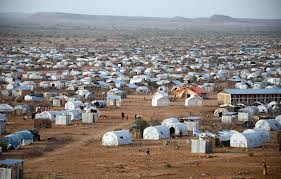Kenyan dilemma of hosting refugees amid ‘Al-Shabaab’ threats

Kenya has harbored more than 500,000 refugees mostly from neighboring Somalia since 1991, however the host government now says “enough” following an university massacre where 148 people were killed in early April by Somalia-based ‘al-Shabaab’ gunmen.
Officials have pointed accusing fingers at the Dadaab refugee camp in northern Kenya—the world’s largest refugee settlement, alleging the Somali refugees there have been hiding and aiding ‘al-Shabaab’ militants.
Northeastern Regional Coordinator, Mohamud Saleh, last week said some refugees were helping the militants by providing them with foodstuff, drugs and transportation of weapons usually by donkey carts.
Soon after the Garissa University attack, the government asked the United Nations (UN) refugee agency, or UNHCR, to close the Dadaab camps and return the refugees to Somalia.
The UNHCR however urged Kenya to reconsider the decision, citing the insecurity in Somalia as a threat to both the refugees and staff of aid organizations if the camps are moved there.
“Despite living in deplorable deprived of enough food, majority of Somali refugees prefer to remain in their host country mainly for the prevailing security,” said Mohamed Abi, leader of a local group promoting peace and reconciliation at Dagahaley, one of the five camps at Dadaab.
There are currently an estimated 423,244 Somali refugees in Kenya, while Dadaab hosts some 350,000 and the number is still increasing.
Most of the young refugees in their twenties were born in Kenya, and consider themselves more as Kenyans than Somalis, Abi told Xinhua on Friday.
“The refugees have adapted into local environment and even the local languages,” Abi said.
“Some of us lost the entire family in Somalia, who will be there even to receive and show us around?” said another refugee, Ahmed Hussein.
Hussein, who is a college graduate, also attributed their refusal to go back to the crippled economy in Somalia.
“There are more than 1,000 of us, who have a university education from various local and international universities and tens of thousands of others with diploma and certificate qualifications, if we are forcibly turned back to Somalia, what will we be doing there?
“There are no job opportunities there,” he said.
So far, the Kenyan government and the UNHCR have repatriated only about 2,000 volunteer refugees since the operation begun last December.
The refugees were to be returned to Kismayo, Banadir and Luug — areas in Somalia believed to be safe after being retaken by African Union troops from ‘al-Shabaab’.
However, more than 100 of those repatriated have sneaked back to Dadaab.
Yusuf Mohamed is one of them.
“I had to return back to the camps because there is nothing happening there.
The place is peaceful now compared to sometimes back, but peace alone is not enough.
There are no schools, health facilities and job opportunities to make me eke out a living,” said Mohamed, who came back from a village in Kismayo.
Meanwhile, the current concentration of inhabitants at Dadaab has put aid distribution in trouble as it has exceeded the camps’ designed capacity by 260,000 people
Each adult refugee at Dadaab receives three kilograms of wheat, a similar amount of dry maize and less than 75 grams of cooking oil from UN agencies twice a month as their food ratio, which is hardly sufficient to keep a person for one week.
And the food ration has been reduced by 30 percent from June 15 due to a decrease in funds from donors, according to the World Food Programme.
To live a better life, many refugees have engaged themselves in doing business, some of which the authorities have claimed to be illegal cross-border trade, wildlife poaching and illicit wildlife trade.
The government has thus declared to put in place measures to restrict free movement of refugees in and out of Dadaab to tackle threats and the illegal business.
.
Xinhua